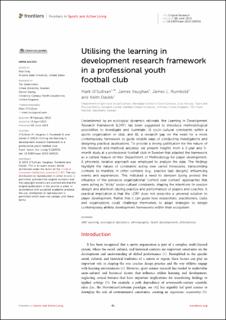| dc.contributor.author | O'Sullivan, Mark Joseph | |
| dc.contributor.author | Vaughan, James | |
| dc.contributor.author | Rumbold, James L. | |
| dc.contributor.author | Davids, Keith | |
| dc.date.accessioned | 2023-10-23T13:24:23Z | |
| dc.date.available | 2023-10-23T13:24:23Z | |
| dc.date.created | 2023-07-12T10:11:14Z | |
| dc.date.issued | 2023 | |
| dc.identifier.citation | Frontiers in Sports and Active Living. 2023, 5, Artikkel 1169531. | en_US |
| dc.identifier.issn | 2624-9367 | |
| dc.identifier.uri | https://hdl.handle.net/11250/3098171 | |
| dc.description | This is an open-access article distributed under the terms of the Creative Commons Attribution License (CC BY). The use, distribution or reproduction in other forums is permitted, provided the original author(s) and the copyright owner(s) are credited and that the original publication in this journal is cited, in accordance with accepted academic practice. No use, distribution or reproduction is permitted which does not comply with these terms. | en_US |
| dc.description.abstract | Underpinned by an ecological dynamics rationale, the Learning in Development Research Framework (LDRF) has been suggested to introduce methodological possibilities to investigate and illuminate: (i) socio-cultural constraints within a sports organization or club, and (ii), a research gap on the need for a more contemporary framework to guide reliable ways of conducting investigations and designing practical applications. To provide a strong justification for the nature of the fieldwork and methods adopted, we present insights from a 3-year and 5-month study at a professional football club in Sweden that adapted the framework as a central feature of their Department of Methodology for player development. A phronetic iterative approach was employed to analyze the data. The findings highlight the nature of constraints acting over varied timescales, transcending contexts to manifest in other contexts (e.g., practice task designs), influencing events and experiences. This indicated a need to dampen (using probes) the influence of the pervasive organizational “control over context” approaches that were acting as “sticky” socio-cultural constraints, shaping the intentions (in session design) and attention (during practice and performance) of players and coaches. A practical implication is that the LDRF does not prescribe a universal solution to player development. Rather that it can guide how researchers, practitioners, clubs and organisations could challenge themselves to adapt strategies to design contemporary athlete development frameworks within their ecosystem. | en_US |
| dc.language.iso | eng | en_US |
| dc.subject | affordances | en_US |
| dc.subject | ecological dynamics | en_US |
| dc.subject | ethnography | en_US |
| dc.subject | skill learning | en_US |
| dc.subject | talent development | en_US |
| dc.title | Utilising the learning in development research framework in a professional youth football club | en_US |
| dc.type | Peer reviewed | en_US |
| dc.type | Journal article | en_US |
| dc.description.version | publishedVersion | en_US |
| dc.rights.holder | © 2023 O'Sullivan, Vaughan, Rumbold and Davids | en_US |
| dc.source.pagenumber | 17 | en_US |
| dc.source.volume | 5 | en_US |
| dc.source.journal | Frontiers in Sports and Active Living | en_US |
| dc.identifier.doi | 10.3389/fspor.2023.1169531 | |
| dc.identifier.cristin | 2162067 | |
| dc.description.localcode | Institutt for idrett og samfunnsvitenskap / Department of Sport and Social Sciences | en_US |
| dc.source.articlenumber | 1169531 | en_US |
| cristin.ispublished | true | |
| cristin.fulltext | original | |
| cristin.qualitycode | 1 | |



